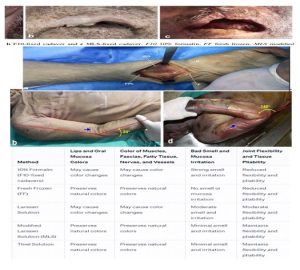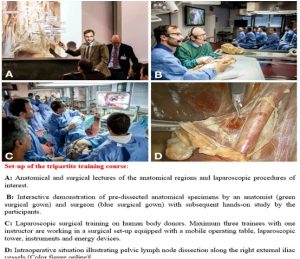Assistant professor ahmed hamza abboud Al- Janabi
College of Medicine
A) Introduction:
There are two main methods for endoscopic surgical training: Cadaveric-based Training and Virtual Reality (VR) Simulation. Cadaveric training provides a realistic anatomical context for junior doctors to hone their skills, while VR simulation offers a simulated surgical environment for skill development.
B) Aim:
– To introduce these methods to junior doctors and explain their advantages and characteristics.
– To explore the roles of anatomist and experienced surgeon in these centres
1. Cadaveric Training
a) Advantages.
1. It provides surgeons with a realistic anatomical representation for practicing various
procedures,
2. It allows them to develop their skills in a controlled environment.
b) Preservative methods:
There are many types of preservatives used in cadaveric training for surgical purposes.
These include formaldehyde-based solutions like formalin, Thiel embalming, Silicone-based
preservation and Ethanol-based preservation.
The main targets for select the embalming solution are
1) Suitable, simple, cost-effective,
2) Preserving colour, texture, pliability and flexibility of the tissues for a long time
3) Without a disturbing smell and mucosal irritation.
The best solution has these criteria is Thiel embalming solution which is widely used.
Now, we discuss the advantages and disadvantages of Thiel embalming method: surgeons with a realistic anatomical representation for practicing various procedures,
i. Advantages:
1. Reduces tissue rigidity and discoloration,
2. Enables more accurate simulation of surgical procedures.
3. Preserves the cadaver in a closer resemblance to living tissue, so it allows for improved
haptic feedback and a more realistic training experience.
4. Facilitates the manipulation of structures and the demonstration of dynamic movements,
so that it enhances the educational value of cadaveric training.
ii. Disadvantages, such as:
1. higher cost
2. longer embalming time,
3. needs a specialized expertise.
Therefore, Training centers must carefully evaluate their specific needs and
resources before choosing the preservation method.

2. Virtual Reality (VR) Simulation
a. Definition:
⦁ It is an emerging alternative to cadaveric training in endoscopic surgery.
⦁ It creates a simulated surgical environment using computer-generated graphics and haptic feedback,
⦁ It allows the surgeons to practice procedures in a virtual setting.
⦁ It uses computer-generated images rather than real images of the human body. But with the rapid advancements in technology, we suspect improvement of its realism at any moment, to integrate actual patient imaging data for more accurate anatomical representations. This really happened in the field of radiography
b. Advantages:
⦁ Repeatable training scenarios: it permits the surgeons to practice procedures repeatedly, hons their skills and improves performance.
⦁ Real-time feedback: it offers immediate feedback on instrument handling, procedural accuracy, and overall performance.
⦁ Cost-effectiveness: it eliminates the need for cadaver procurement, storage, and disposal, reducing associated costs.
⦁ Remote learning and collaboration: it enables the trainee to access VR training modules from different locations, therefore, it facilitates remote learning and expert guidance.
⦁ Procedure-specific training: its provide focused training modules for specific endoscopic procedures, allowing the trainee to target his skill development.
C)Types of endoscopic operation that can be practiced: it enables surgeons to practice a wide range of endoscopic operations, such as:
1. Laparoscopic procedures: Cholecystectomy, appendectomy, hernia repair, etc.
2. Gastrointestinal endoscopy: Esophagogastroduodenoscopy (EGD), colonoscopy, endoscopic retrograde cholangiopancreatography (ERCP), etc.
3. Urologic endoscopy: Cystoscopy, ureteroscopy, prostate surgery, etc.
4. Gynecologic endoscopy: Hysteroscopy, laparoscopic hysterectomy, myomectomy, etc.
D) Conclusion,
-Both cadaveric training and VR simulation play important roles in endoscopic surgical training.
While VR simulation has many benefits in terms of accessibility and cost-effectiveness, it cannot
fully replicate the tactile feedback and complexity of real surgical procedures. Therefore, it can be
used as a complementary tool rather than a complete replacement for cadaveric training.
-Therefore, the Junior doctors should take an integrated approach to training by combining both
cadaveric training and VR simulation to maximize their educational experience and improve
patient outcomes.
– In these training centres, anatomists and experienced surgeons work together to provide trainees
with a comprehensive educational experience.
Anatomists provide trainees with the necessary anatomical background and knowledge to understand the structures and systems they will be working with during endoscopic procedures. They help trainees identify and locate anatomical landmarks and understand the relationships between different structures.
Experienced surgeons, on the other hand, provide trainees with technical guidance on how to perform endoscopic procedures. They demonstrate proper instrument handling and technique, and provide feedback on the trainee’s performance. They also share their own experiences and insights to help trainees develop their decision-making skills and clinical judgment.
Together, anatomists and experienced surgeons provide a well-rounded educational experience that combines both theoretical knowledge and practical skills. This helps trainees develop the necessary expertise to perform endoscopic procedures safely and effectively.
E) Recommendation
– Establishing an Endoscopic Surgical Training Center in Iraq using VR simulators due to religious reasons against preserving cadavers. Such a center would provide junior doctors with access to experienced trainers and hands-on experience in performing endoscopic surgeries.






























































